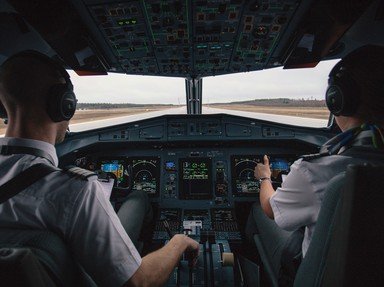Quiz Answer Key and Fun Facts
1. There are exceptions, but most aircraft take off and land at an airfield or airport. These are given international codes with four characters such as KLAX for Los Angeles International and EGLL for London Heathrow. Which organization, a part of the United Nations, assigns them?
2. During pre-flight checks we verify that all lights work properly. What colors, the same as those used on ships, do the navigation lights at the wingtips have?
3. Pre-flight checks completed, we can taxi to the runway and take off. Can I take off without having permission, just like I can drive away with my car?
4. We are off! We are accelerating down the runway and I gently pull the yoke ("steering wheel") towards me to lift off the ground. The yoke is connected to a control surface at the tail end of the aircraft that causes the nose to pitch up. What is that control surface called?
5. Now we are climbing to our chosen cruise altitude. I use the altimeter to let me know how high we are at all times. How do most altimeters work?
6. I consult my map and I see that we have 60 nautical miles (NM) to go. That is about 69 miles or 111 kilometers. We are traveling at 120 knots. How long time will it take us to get there?
7. When talking to the air traffic control, I identify myself with the registration mark of the aircraft. Flying mostly Swedish aircraft, that registration starts with the letters "SE". How do I say that on the radio?
8. Approaching our destination, I reduce the speed to prepare for landing. It is the speed that keeps us flying: without it the wings do not generate any lift and we would quickly lose altitude. What is the term for the speed under which the lift drastically reduces?
9. Just before the landing, I want to fly at a speed that is very close to the aircraft's normal stall speed, which is a bit risky. What can I do to increase my safety margin?
10. After landing, I need to turn off the little gadget that allows air traffic control to see where I am when I'm in the air. What is that called?
Source: Author
akg1486
This quiz was reviewed by FunTrivia editor
stedman before going online.
Any errors found in FunTrivia content are routinely corrected through our feedback system.

